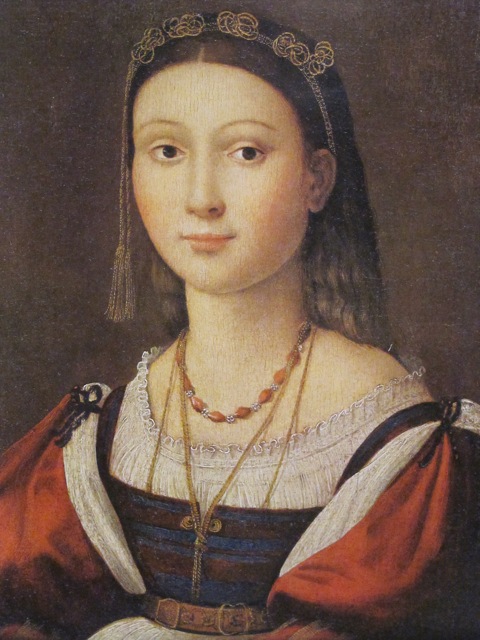The Boston Raphael: A Curious Case
On June 23, 2005, I arrived in Florence with an appointment to view one small painting that had dropped out of sight more than 20 years before. I had learned that the picture—at one time attributed to the Renaissance master, Raphael—was in storage in the Uffizi Gallery and would require special permission to see. In a small, windowless room stacked with paintings floor to ceiling, a preparator in a white smock unveiled the eight x ten inch portrait of an adolescent girl with a moon-pale face and almond eyes, exquisitely dressed in Renaissance finery. I remembered her well—that trace of a smile was as benign as ever, and as innocent of the upheaval she had caused.

Perry T. Rathbone in portrait session with Yousuf Karsh, Museum of Fine Arts, Boston, 1965. Photo: Ivan Dmitri
On a mid-summer day 36 years earlier, another party had gathered around the very same painting at the gallery of an elderly art dealer in Genoa. My father, Perry T. Rathbone, was considering its acquisition for the Museum of Fine Arts in Boston, where he was then director. This would be a coup for the MFA, which was about to celebrate its centennial year, 1970. Nothing could adorn the centennial celebrations more than a previously unknown work by one of the greatest artists who ever lived. Nothing could crown my father’s 15-year directorship of the MFA more gloriously than such a treasure.
As it turned out, the fateful meeting and the purchase that followed would be the beginning of an art-world cause célèbre of international scope, a milestone in the history of art collecting, and also the unraveling of my father’s long and distinguished career as a museum director.
Soon after its unveiling in Boston in December, 1969, art experts on both sides of the Atlantic questioned the portrait’s attribution to Raphael. At the same time, Italy’s top art sleuth, Rodolfo Siviero, began investigating the manner of the painting’s exportation from Italy and arrival in Boston. Following months of widely publicized controversy on both fronts, the MFA trustees were persuaded to return the painting to Italy in September, 1971, where it has languished in obscurity ever since.
The little portrait had become the object of a contest. While its acquisition was designed to serve one purpose—as a centennial prize for the MFA and the crowning acquisition of my father’s tenure; its return to Italy served another—as a trophy for Rodolfo Siviero. For both parties, it was essential to believe in the attribution to Raphael. In retrospect, given the painting’s consignment to storage and its demotion from Raphael to “Emilian School,” it was not only an embarrassment to the MFA but a false victory for the motherland.
My father believed in the injustice of the episode for the rest of his life: first that the trustees had abandoned him in his time of crisis; and second, that the Italians had reclaimed a picture that they apparently had little use for. The story of “The Boston Raphael” trailed him all the way to his obituaries when he died in January 2000. For all his many triumphs, this fiasco remained, as he himself once called it, the greatest adventure of all.
While I understood his motives implicitly, I could not help but wonder where his judgment had gone wrong? To what extent was he the victim of circumstance, of changing times, and a cluster of conflicting personalities closely involved in the case? How could the ground have shifted under him so suddenly? Or had it been shifting, imperceptibly to him, for years?

: Attributed to Raphael, Portrait of a Young Girl, Uffizi Gallery, Florence (storage), 2005. Images courtesy of Belinda Rathbone.
In his prime, Perry Rathbone was one of the most influential museum directors in America—a connoisseur of great breadth as well as a brilliant showman. Over the course of 32 years, he played a crucial role in the modernization of the American art museum—from quiet repositories of art to palaces for the people. As director of the St. Louis Art Museum from 1940 to 1955, and the Museum of Fine Arts, Boston, from 1955 to 1972, he ambitiously moved both museums forward into the post-war era. As a member of the first generation of Harvard-trained museum professionals, he was a key player in the post-war revision of the very concept of the American art museum.
The story of the Boston Raphael is inseparable from another, larger story. No small part of this event was the political turmoil brewing within the MFA in the late 1960s. It was a museum in the flux of change and in the throes of ideological conflict, as its size, its scale of operations, and the value of its collections reached a tipping point. Significantly, philosophical questions of that bygone era remain with us today, even as the landscape has vastly changed. The conventions of exporting works of art, the methods of research and authentication, the ways that museums are managed and the priorities that have recently overtaken them—all three of these issues turned a decisive corner during and in the immediate aftermath of the Raphael affair, just as they were elements in its outcome.
As inevitable as the Renaissance portrait’s return to Italy may now seem, I have long been determined to investigate the circumstances and personalities involved in this curious case, the story behind the story. My forthcoming book, Raphael in the Court of Boston, has been driven by my father’s own words. “It was absurdly handled,” he told an interviewer in 1981, “and someday, if I live long enough, I hope to have the strength to write about it.”
